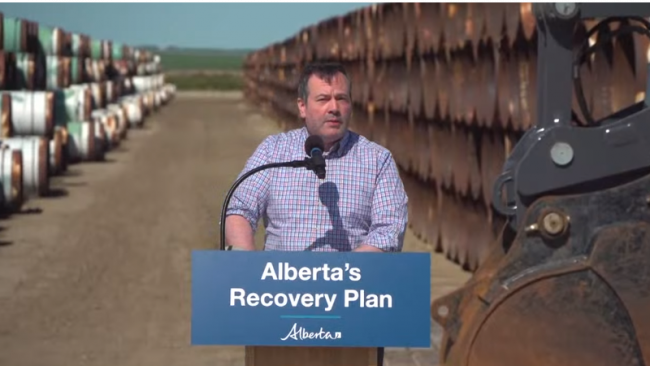If we’re going to have economic stimulus, it ought to be green. That sentiment has achieved surprising levels of agreement around the world, and not just from the usual suspects.
Nobel-winning economists, financial experts and even the highly conservative International Energy Agency (IEA) are all pushing governments to use stimulus to decarbonize the economy.

And for good reason: the last time we had a financial meltdown it was followed by a record surge in fossil fuel burning.
Have a look at this first chart.
Despite decades of promises to prevent a full-blown climate crisis, its primary cause — fossil fuel burning — was rising relentlessly.
Then the Great Recession hit in 2008-9 and caused the only drop in global fossil fuel burning in the last 30 years.
At the time there was hope that governments would use their huge, future-shaping stimulus to transition to a climate-safe economy.
To see what actually happened, look at the next chart.

Instead of a climate-safe recovery, fossil fuel burning surged upwards in 2010 by the greatest amount in history.
And every year since then, despite all the global protests, the gatherings of the United Nations, the boom in renewable energy — despite everything — humanity has continued to burn even more fossil fuels with each passing year than in the year before.
Now, in 2020, the coronavirus pandemic is raging across the globe.
A report from the IEA projects the resulting global economic contraction will push fossil fuel burning down about eight per cent this year. That's the dotted blue line on the chart.
And then what? According to the IEA, “a similar rebound in emissions can be expected after this crisis unless there is effort by governments to place clean energy transitions at the heart of the economic recovery.”
It’s not just that economic stimulus is an opportunity to accelerate the transition to a net-zero economy. It’s crucial that we don’t accelerate deeper into danger, like we did after the last recession. After all, the climate doesn’t care how much clean technology we deploy, it only cares how much carbon builds up in the atmosphere from the fossil fuels we burn.
So, the question for every government becomes: how much money are you spending on fossil fuels during the pandemic recovery?
Fortunately, a new coalition has come together to track the answers from each of the world’s largest economies. We’ve taken this data compiled by Energy Policy Tracker and charted new government support for fossil fuels by each of the G20 countries since the beginning of the COVID-19 crisis. (Note that to allow fair comparisons across countries, the charts list all values in USD per capita.)

As you can see in this first G20 chart, Canadians are at the top of the fossil support charts. Canada has committed nearly ten times the G20 average per capita — for a total of $12 billion so far this year in new fossil fuel support. Only France, with its massive bailout of Air France, has managed to spend more per person, at this point.
You can also see that we’ve added a little green cap onto the top of the bar representing Canada. That’s the amount of money Canadian governments have committed to clean energy (again, per capita). We could belabour this point but, really, the prioritization speaks for itself.
Now, it’s worth pausing to make a few points here.
Canada has committed nearly ten times the G20 average to fossil fuels per capita — for a total of $12 billion since the pandemic
First is that this is a running tally of money committed since the pandemic began. So, the numbers for clean and fossil energy will keep rising as new policies are announced. The coalition updates the tracker every Wednesday.
Second, Energy Policy Tracker is only tracking money explicitly committed to energy. More general spending that benefits the energy sector along with others isn’t represented here, so the actual support to the energy sector is significantly higher.
And finally, as the coalition points out, “these public money commitments are additional to many other government policies that had existed to support different energy types before the COVID19 pandemic” (emphasis added).
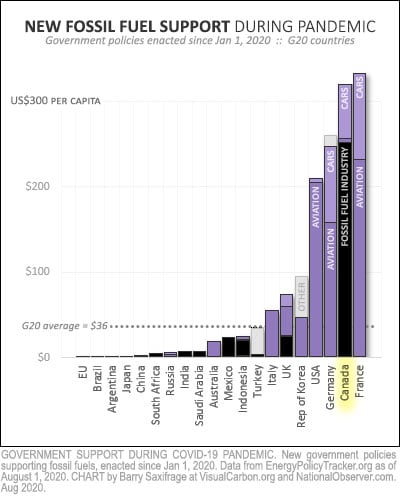
Now, let’s get back to the charts.
You may be wondering about the specifics. The next chart shows the top 3 categories where countries have been directing fossil energy support: aviation, ground transportation (which includes support to gasoline and diesel vehicles as well as expanding highways and bridges) and the fossil fuel industry itself.
The aviation industry is the biggest overall recipient of new public funds being pumped into fossil fuel burning.
But at this point, Canadian governments have focused most of their public funds on the fossil fuel industry itself.
One thing you may notice is that despite all the news about U.S. President Donald Trump bailing out U.S. coal and the American oil and gas industry, not much money has actually been committed.
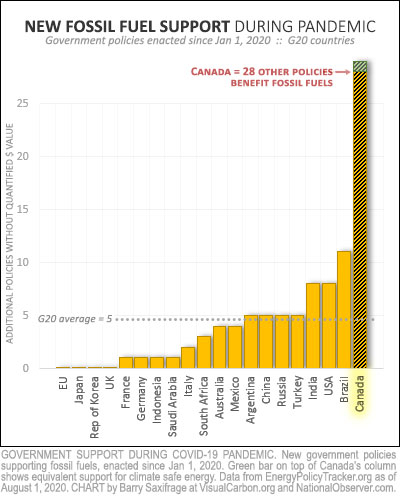
Instead, most of Trump’s support for fossil industries has come in the form of rollbacks to regulations and environmental safeguards.
There has been a lot of handwringing about this issue in the U.S., so the next chart shows the number of additional policies that benefit fossil fuels but where the “value of public money is unquantified.”
And for Canada, we have included the number for clean energy — just one so far — as a green bar on top.
Clearly much more media scrutiny should be directed to this topic in Canada, especially considering the latest news of major cuts to environmental monitoring of the oilsands.
The Energy Policy Tracker includes policies from both national and subnational governments. In Canada, the provinces are playing an oversized role, as the next chart shows.
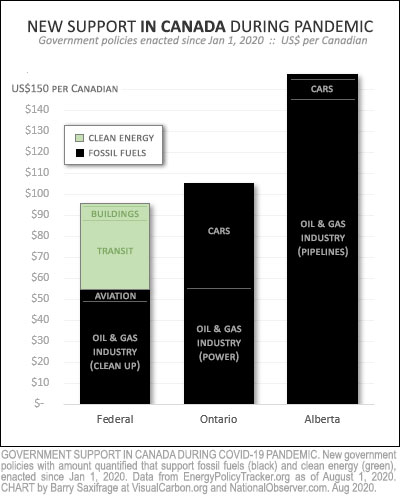
Here we finally find some positive news. The federal government has put a much higher priority on supporting clean energy than the overall Canadian numbers suggest.
And the overwhelming chunk of its support for fossil energy is directed at cleaning up abandoned oil wells — a subsidy for the oil and gas industry, to be sure, but one where there’s at least a public interest argument.
Ontario is pumping double the feds’ numbers into support for fossil fuel burning — by purchasing power plants running on fossil gas as well as almost two billion for highways and bridges.
Alberta has committed more than three times the federal numbers with the province’s commitments to invest directly in the Keystone XL pipeline and guarantee its loans next year.
What’s even more striking is that, to keep things consistent, we’ve kept using per capita numbers, per Canadian. So, the provincial commitments to fossil fuel burning per provincial resident would be much higher. For example, Alberta's fossil support works out to $1,370 per Albertan. Way off the charts.
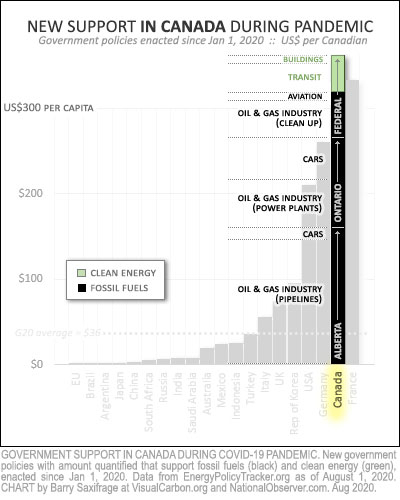
If you’d like to see how those two provinces stack up against entire G20 countries (even using those conservative per Canadian numbers), take a look at this chart.
We've broken down the Canadian bar to show the public money committed to energy by Alberta, Ontario and the feds, as well as where that money is going. And you can see how it all compares to the world's other major economies.
Alberta and Ontario are burning their way almost to the top of the G20 fossil charts by themselves.
To close out this sobering look at Canadian governments’ support for fossil energy in a time of pandemic, let’s remember that the situation isn’t a COVID-19 anomaly.
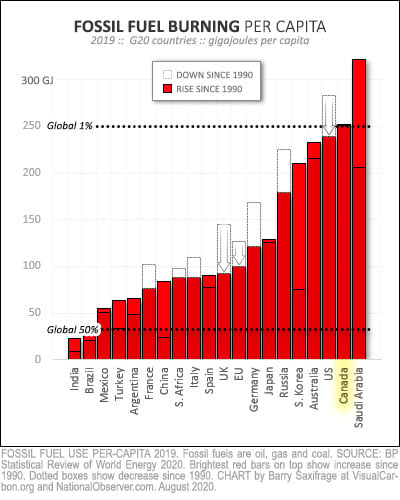
As the final chart shows, when it comes to the amount of fossil fuels burned every year, Canada is second only to Saudi Arabia in the G20 — in terms of total fossil burn per capita.
Both countries are in the global top one per cent, burning more fossil fuels per person than 99 per cent of humanity.
And unlike our peers in the United States, the European Union and the United Kingdom, we haven’t yet begun to reduce our burn rate at all.
Canadian governments will be rolling out more pandemic recovery spending in the months to come. We will see how much of a priority they place on the clean energy transition.
Green stimulus would certainly be better than more support for fossil fuels. But it’s even more important that we start dousing the fire. Canada does not yet have a plan to meet its commitments under the Paris agreement. Let alone a plan to achieve the federal government’s promise of net-zero carbon emissions by 2050.
So, yes, if we’re going to have economic stimulus, it ought to be green. But let’s put out the fire that’s already blazing.
[Top photo: Alberta Premier Jason Kenney with pipe destined for the Keystone XL pipeline, July 3, 2020. Photo by Government of Alberta]
